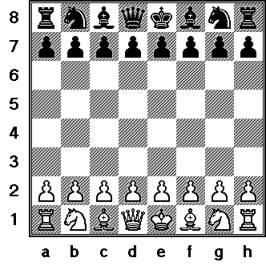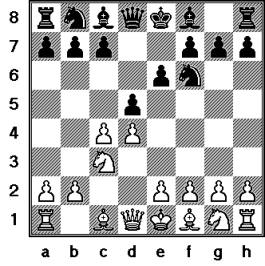 Starting position with chess
letters and numbers
Starting position with chess
letters and numbersHOW
TO READ AND WRITE CHESS MOVES
In chess, it is important that we have a way of writing the moves played
in a game. This is called keeping score. We also need a way of talking chess,
telling someone else what move was made or suggesting a move to be made. It is
important that anyone on a chess team learn how to write and talk chess moves.
Here is how we do this.
 Starting position with chess
letters and numbers
Starting position with chess
letters and numbers
The numbers and letters along the edge of the board are to help you write
and talk chess moves. Each square has a name. You name a square by using the
letter and number for that square. For example, the square the king is on at the
start of the game is e1. The square the pawn in front of the queen is on at the
start of the game is d2. Each square has a name using a letter and number for
it. The letter is a small letter (not a capital letter).
We say what a move is by saying what was moved and where it went. For
example, if we move the knight on the king side of the board out two squares and
over one square toward the center––its favorite square––that move is
Nf3. As you see, we use a letter to say what piece was moved. (The reason we use
an N for the knight is the letter K is used for the king.) Every piece except
the knight uses the first letter of its name, as below.
K
is king Q is
queen R is rook B is bishop
N is knight
For
a pawn, we do not use any letter (instead of using a P). If you move the pawn in
front of the king two squares, this is written as e4. If you move the pawn in
front of the queen one square, this is written as d3. So if no letter is used,
we know it must have been a pawn move.
If there is a capture made with a move, we use an x to show this. So an x
means takes. For example, if white plays the first move 1.e4 and black answers
1...d5, a pawn capture at move two by white is written as 2.exd5. That shows the
white pawn took the black pawn. If white plays the first move 1.Nf3 and black
answers 1...e5 (A terrible move that loses a pawn), the knight taking the pawn
at move two is written as 2.Nxe5.
 Position after three moves for
each player
Position after three moves for
each player
In this position, here were the first three moves for each side and how
they were written:
White
Black
1.d4
d5
2.c4
e6
3.Nc3
Nf6
Here
are the rules on how to write chess moves:
(1)
All the moves are numbered, with a dot after the number.
(2)
Pieces use a capital letter, squares use a small letter.
(3)
Castling is written as 0-0 for castling on the king side, or 0-0-0 for castling
on the queen side.
(4)
If a move is a check, we put a + after it. So 3.Bb5+ means white checked black
at move three.
(5)
Sometimes we get a move where we have to say which of two pieces was moved to a
square. For example, if we had a knight on c3 and a knight on e3, and we played
a knight to d5, we would have to say which knight went there. (Both knights here
can go to d5.) We do this by saying what square the knight came from. So if our
knight on c3 went to d5, we write this as Ncd5. (As you see, all we need to do
is give the letter of the square it came from, as this is enough to tell which
knight was moved.)
(6) If we make a capture using the en passant rule, this can be written as:
dxc6 e.p.
(7) If we queen a pawn, this can be written as d8(Q).
(8) A checkmate is written like this: 10.Qxf7
mate (or this way:
10.Qxf7#)
(The
white queen took on f7 at move ten and mated the black king).
(9)
If a player gives up, we use the word resigns.
(10)
If we want to say if a move was good or bad
(not required), we can do it this way:
Put ? after a bad move.
Put ! after a good move.
In order to play on a chess team or in a chess tournament, or to read a book about chess, you need to learn how to read and write chess moves. It is a good idea to practice this by keeping score even when you play a friendly game in the chess club.
Contributed by Bob Ciaffone, a coach from Michigan